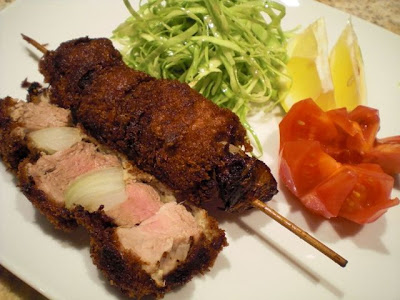Here, I used pieces of pork tenderloin and onion skewered alternately on bamboo skewers. Some commercial establishments (not good Izakayas) may use a batter (water and flour) to coat the skewers before breading but this will usually make a very thick and oily crust. I use a more traditional method of dredging the skewered meat and onions in flour (AP flour), dipping it in an egg wash, and finally coating it in Japanese Panko crumbs (as described in the recipe in Mark's book). I deep fry using a low-meidum temperature since it will take some time to cook the pork through (15 minutes or more depending on the size of the pork). I sliced along the skewer to show the pork onion layering as it was done in the Mark's book illustration but, of course, you should just serve the skewers without cutting it. Serve this with a Japanese hot mustard and "tonkatsu sauce". The usual accompaniment is a thinly shredded cabbage but I lightly dressed the cabbage with my version of honey-musdard dressing as per my wife's request (she said she can not face a mound of a raw shredded cabbage). This dish can go with sake, beer, or red wine. We had this dish with a nice California Cabernet Sauvignon Flora Springs 2005.
Monday, October 26, 2009
Deep-fried pork and onion skewer 豚肉とタマネギの串揚げ
Deep-fried pork and onion skewer 豚肉とタマネギの串揚げ (Mark's book p60)
This is also a very popular item either in Izakayas or restaurants specialized in "kushiage" 串揚げ. Kushiage ("kushi" means a skewer and "age" means to deep fry) is skewered small pieces of meat, fish, or vegetables, breaded and then deep dried. My wife and I are getting too old to have an entire meal of deep dried food either kushiage or tempura. But we enjoy few deep fried items in Izakayas. This combination of pork and onion is very common and very good. We mentioned "Muroran"-style yakitori with this exact combination. Onion and pork cooked together impart some synergetic enhancements of each flavor.
Labels:
Deep fried,
Pork
Subscribe to:
Post Comments (Atom)


No comments:
Post a Comment